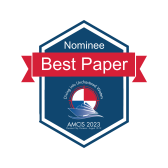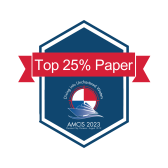Loading...
Paper Type
Complete
Description
The manufacturing industry is one of the biggest beneficiaries of artificial intelligence (AI). However, to reap the value and fulfill all the necessary activities, they realize it involves a multitude of different capabilities and resources. Therefore, firms increasingly establishing innovation ecosystems that animate both, (inter)-organizational cooperation, and intra-ecosystem competition among participants. But beyond resources and capabilities, what are the reasons that independent organizations become members in the first place, and how do they secure their position in a field of dynamic competition and collaboration? This study applies an exploratory multi-case study with ten cases from the manufacturing industry. Based on a business model and role of value network perspective, our findings reveal 16 BM characteristics that add to a competitive advantage and therefore ecosystem membership. Our study contributes to the research on competitive advantage in innovation ecosystems, strategic management, and the growing streams of research on artificial intelligence.
Paper Number
1277
Recommended Citation
Scepanski, Erik; Schoemer, Daniel; Zillner, Sonja; and Laumer, Sven, "Survival of the Fittest: A Business Model Perspective to explain Innovation Ecosystem Membership" (2023). AMCIS 2023 Proceedings. 1.
https://aisel.aisnet.org/amcis2023/sig_scuidt/sig_scuidt/1
Survival of the Fittest: A Business Model Perspective to explain Innovation Ecosystem Membership
The manufacturing industry is one of the biggest beneficiaries of artificial intelligence (AI). However, to reap the value and fulfill all the necessary activities, they realize it involves a multitude of different capabilities and resources. Therefore, firms increasingly establishing innovation ecosystems that animate both, (inter)-organizational cooperation, and intra-ecosystem competition among participants. But beyond resources and capabilities, what are the reasons that independent organizations become members in the first place, and how do they secure their position in a field of dynamic competition and collaboration? This study applies an exploratory multi-case study with ten cases from the manufacturing industry. Based on a business model and role of value network perspective, our findings reveal 16 BM characteristics that add to a competitive advantage and therefore ecosystem membership. Our study contributes to the research on competitive advantage in innovation ecosystems, strategic management, and the growing streams of research on artificial intelligence.
When commenting on articles, please be friendly, welcoming, respectful and abide by the AIS eLibrary Discussion Thread Code of Conduct posted here.





Comments
SCUIDT